Sarah Thomason (Hellene School Travel)

Several Teachers have made enquiries. However, as we NEVER send ANYONE ANYWHERE (unless you insist) it was time to plan…………..
Thus, we were quite chuffed when we read Prof. Edith Hall’s glowing recommendation about Albania (The Edithorial: ALBANIA: Why You Need to Visit NOW) because we had already made plans with Archaeologist, Lecturer, Tour Guide, ex B.M. and current Albanian resident Carolyn Perry (@CarolynPPerry)
Day 1 – BA Flight Gatwick/Tirana. Aragosta Hotel, Durres
We had a rather spectacular welcome to Tirana and Durres. Zeus was alive well and obviously not too happy about anyone sharing his airspace.
Jimmy Lama (Tours Albania & Balkans) safely guided us through torrential rain, gales and floods to the warmth of the hotel and a veritable piscatorial feast. Moses had nothing on this guy!
Carolyn waited up for us despite the long delay and loaned us Oliver Gilkes book for the week.
Obviously, we had brought gifts of immeasurable value and sophistication:

Day 2 – Durres/Epidamnus/Dyrrachim. Archaeological Museum, Amphitheatre, Forum and Roman Bathsby private arrangement
Our first day proper and we set out to explore Durres. Originally Epidamnus an Ancient Greek Cleruchy founded by Colonists from Corinth and Corcyra (Corfu) it later became Roman Dyrrachium.
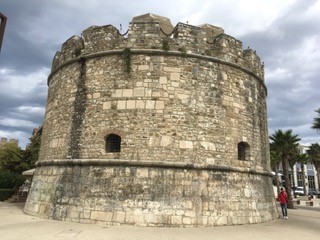
Whilst waiting for Carolyn at the Venetian Tower (now cafe) built of Hellenistic spolia, we (honestly!) discussed the causes of Peloponnesian War, Thucydides, Cicero, Hadrian and hugely contrasting street sculpture.
There’s an awful lot of spolia around Durres!
Carolyn took us first to a Late Roman/Early Byzantine 40m diameter concentric structure with colonnade. A Curved Forum? The central column as gifted by Emperor Anastasius marking the start of the Via Ignatia?
My inexpert guess is a Macellum similar to the Pozzuoli ‘Seraphaeum’.
Courtesy of Carolyn, we were able to enter and spot a Roman Board game incised into the pavement.

What lies beneath the paving and theatre of Durrës, Dyrrachium? A Roman Thermae of course! Once again, thanks to Carolyn who knows the ‘very nice man with the key’ we were permitted entry.
We were not the only ones to enthuse.
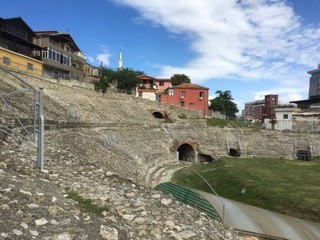
Together we visited Trajan’s Amphitheatre. Unusually, it is not free standing. One side is built into the hillside (possibly incorporating an earlier Greek Theatre), the elipse is very clear as are various engineer marks. Also incorporated are areas of Christian worship and early Byzantine Mosaics.
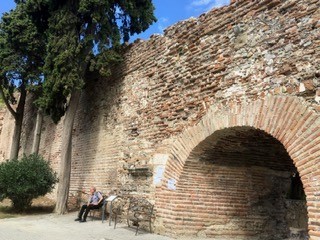
The Ancient Walls and Gateways we explored on our own in search of lunch. The original Illyrian defences were expanded by Anastasius, Justinian and later the Venetians and Ottomans.
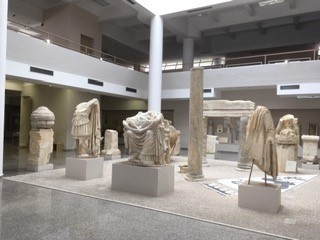

Our visit to the Archaeological Museum resulted in somewhat rushed and surreptitious photography. Minus the necessary permit, there was only so much to which a Guard’s blind eye could be turned! Excellent exhibits vary from Archaic Terracotta Akroteria to polychromatic stele and mosaics.
The Museum’s garden boasts epigraphy, funerary stele, fountains and sections of Hadrianic aqueduct.
Evening drinks whilst poring over maps and taking copious notes, we planned our forthcoming excursions beneath a beautiful sunset.
Day 3 – Amantia. Araxontiko Hotel, Himare
Before leaving, we picked up fruit and veg from a market stall for a picnic lunch en route.
Albanian motorways are exceptional and without tolls. Side roads are lined with many Communist Era Memorials…..some spectacular, some humble, some better attended than others.
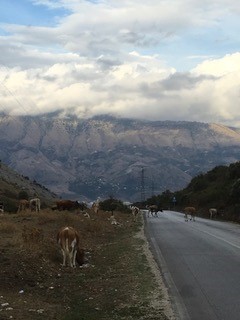
Goats we expected…. but not so many pigs, turkeys, cows – or Oil Wells!

Eventually, we arrive at Hellenistic Amantia. Claiming Euboean origins, (possibly to qualify for the Pythian Games) it sided with Caesar during the Civil War. The Stadium remains are impressive – as is the hike to the Akropolis with two Temples, circuit walls and gateways.
A young farmer guided us up to the 5 agricultural homesteads set within the archaeology. Mid hike we met his father descending with a Civil Engineer – a road is planned.
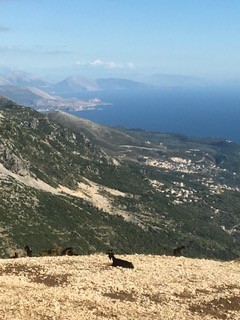
Leaving the spectacular mountain scenery around Amantia we continue south onto the equally spectacular Adriatic Coast…….and more goats.
In Hamare we are most chuffed to be introduced to the sons of our Host – Miltiades and Homeros! It’s an old Greek enclave. Unplanned, the hospitality was quite superb……..we slept like logs.
Day 4 – Sarande, Butrint/Buthrotum, Hadrianopolis. Kalemi 2 Hotel, Gjirokastra
A very decent breakfast sets us up for the day. Fresh peach juice, cheese, eggs and Loukoumades with Jujubes Berry Jam (the Red Dates of Albania).
Onward down the coast we drive to Bouthroton/Butrint – a major Chaonian Epirote Centre & Corinthian/Corcyraean Cleruchy C10th BC.

Traditionally founded by Helenus, son of King Priam, Neoptolemus & Andromache according to Virgil – it’s inundated with Tourists, but so large, that once past the car/coach park………they vanish!

The Gymnaseum and Triconche ’Palace’, a Roman Villa later extended into a luxurious residence c.400 AD was abandoned because of rising water levels. Local fishermen put the abandoned residence to good use.
From the C2nd AD Exedera / Fountain House and Great Basilica we looked across the lagoon to the remains of the Villa of long suffering Atticus, friend of Cicero.

The Circuit Walls are quite extraordinary! Archaic to Mediaeval Sections. Used and reused. Ashlar, Polygonal, Drafted Margins…one amazing gateway inspires comparison to the Scaean Gate of Troy!
There’s even a Greek Gateway from the time of Pyrrhus, early C3rd BC and a reused Archaic relief of a Lion eating a Bulls Head.
The small Archaeological Museum is located down the steps opposite the public toilets! Lovely unfinished togate in a small courtyard, a good selection of Roman Sculpture within, including a mention of Cicero and Atticus.
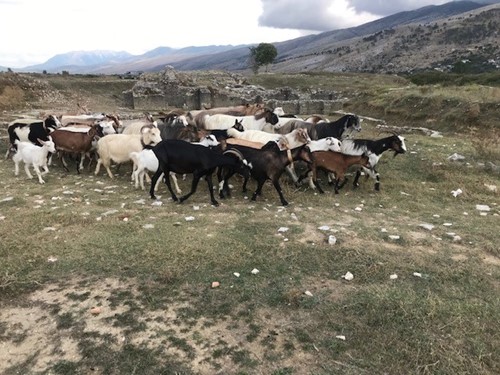
After the bustle of Butrint we detoured to the peaceful isolation of the C2nd AD Theatre of Hadrianopolis. Just us, a large herd of goats, three large sheep dogs and three Italian Geophysicistsinvestigating the Greek circular structure upon which the later orchestra was built.
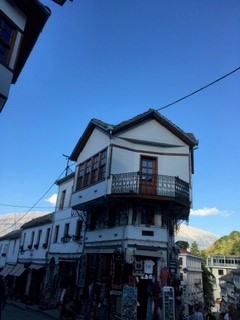
We caught the dying light in the UNESCO Mountain Village of Gjirokastra. Originally C4th AD (Akropolis later housing a notorious prison) in 1336 it was named Argyrokastro. Conquered by the Ottomans in 1417 it changed hands many times during WWII.
Day 5 – Antigonea, Gjirokastra Castle Kalemi 2 Hotel, Gjirokastra
We spend the morning walking Antigonea. Built by King Pyrrhus of Epirus in 295BC he named it after his 1st wife Antigone. Thanks to the Romans, remains are scant. Thus the area is more of a mountain park with scattered archaeology and stunning mountain views. Here we spent a good four or five hours uninterrupted except for birdsong and a small group of French Tourists arriving as we left. What is there however, is good – and it’s a must for any Trip. Take a picnic.
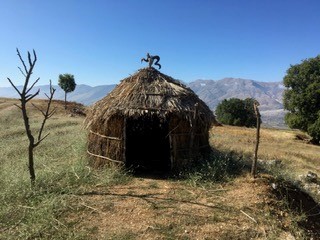
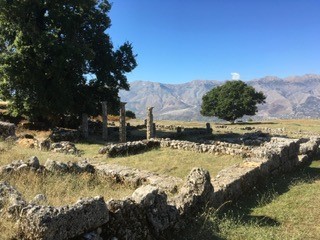
Late afternoon and we explore Gjirokaster Castle. Originally an Ancient Akropolis, later an Ottoman Fortress and 1930s Prison, it is brooding and oppressive although with spectacular views. The Museums within contain ancient artefacts from Antigonea, Hadrianopolis and an array of weapons from ancient Illyrian to WWII.
Day 6 – Byllis Archaeological Park Guva Mangalem Hotel, Berat
It may have taken us an age to locate but eventually we arrived at stunning, breathtaking Byllis! Wow!
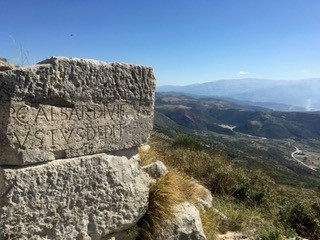
Traditionally founded by Neoptolemus, son of Achilles, the C4th BC Illyrian Akropolis, was subdued by the Romans to become Colonia Iulia Augusta and later a significant Christian Centre under Justinian. Incredible views, marvellous theatre with dolphin decorated seating, epigraphy, altars, cistern, thermae, circuit walls – definitely our favourite site!
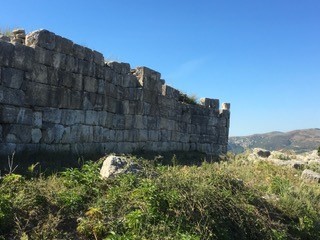
We overnight in beautiful Berat, but first we have to reach our Hotel. We needed sherpas – as it happened, two very fit Greeks from Poros! Our B&B was situated just beneath the C4th BC Akropolis; inaccessible by road we climbed the original kalderimi. Not suitable tor school groups, but should you be travelling independently, we most definitely recommend!

Day 7 – Berat Akropolis and Castle, Apollonia. Oxford Hotel, Tirana
Early this morning and we visit Berat Castle. Originally the Ancient Akropolis of Antipatrea later an Ottoman Fortress, it is now a Heritage Site with Orthodox Churches, Mosque, courtyard housing, Museum, *a lot* of Spolia and a monumental head of Emperor Constantine!

The afternoon we spent at Apollonia (Gylakeia) a C6th BC Greek Cleruchy established by colonists from Corfu/Corinth under Gylax. Mentioned by Strabo, Aristotle & Cicero ‘magna urbs et gravis’ on Via Egnatia, Octavian studied at its Academy and it was here he received news of Caesars death.
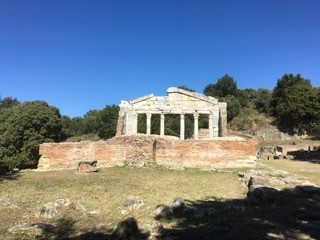
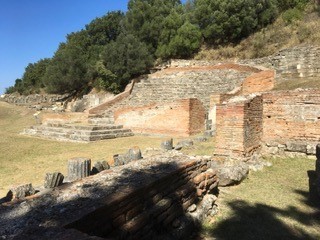
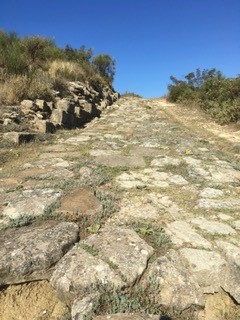
The Museum is housed within the Monastery of Saint Mary, itself built upon a Classical Temple, the remains of which lie partially excavated in the courtyard.


The external corridors, balconies and verandahs are jam packed with artefacts….free standing and wall mounted. Of course, the walls are constructed largely of spolia, including some interesting graffiti.
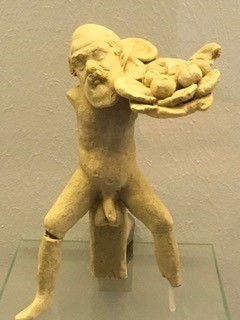
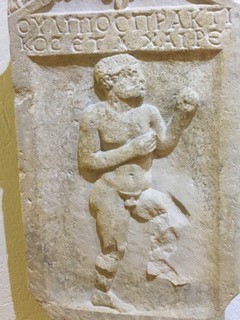
Having shared a beer with one of the Site Guards, we drop him off at a local town and head for the Capital Tirana, our rather swish 3* Hotel and another piscatorial feast near the market.
Day 8 – Tirana Centre and Museums. BA Flight Gatwick
How much can we reasonably see before leaving at 1700hrs for the Airport?
From our breakfast balcony, we take our first good look at breakfast at a City of huge historical, cultural and architectural contrasts.


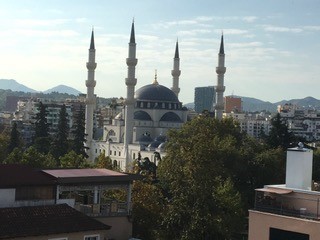
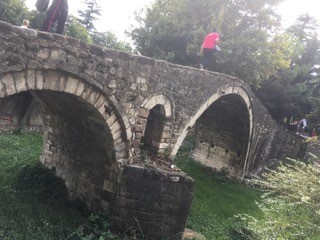
Both Archaeological Museums are a must – anything else is a bonus!
We enter the Ancient Pavilion Rooms Of the Tirana History Museum exhibiting a vast collection of exhibits ranging from Paleolithic to Paleo Christian. We walked beneath a huge Copper x 17 replica of aC3rd BC Illyrian Belt Buckle engraved with Infantry, Cavalry and Dragon Legend of Cadmus.
Some highlights include:-
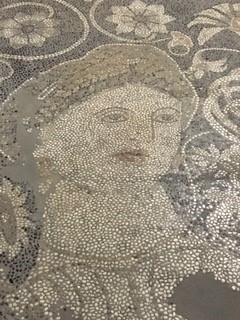
C4th BC Pebble Mosaic – red, black, blue, white, orange from Durres
C4th BC Marble Artemis, Apollonia
Stunning Gladiator Relief C2nd AD, Apollonia
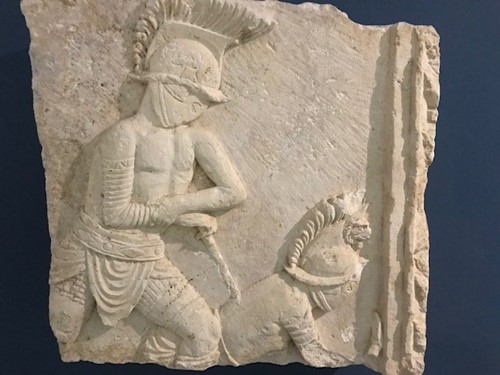
C6th AD Mosaic from Mesaplik / Vlore with early Christian Symbolism & polychromatic tesserae
C3rd BC Illyrian Bronze Weapons and Iron Chain Mail
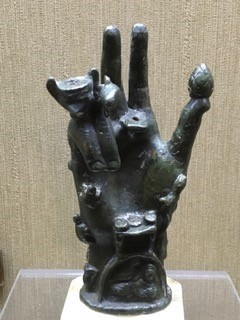
Amazing Hand of Sabazius and Bronze Lamp, Apollonia.
Our final Museum is the National Museum of Archaeology.
The first Museum in Albania founded after WWII on 1/11/1948 & affiliated to the Academy of Science. Not as modern, laid out, labelled or lit as some others….but it has a charm all of its own and contains some surprises such as an exquisite Archaic Statuette and a laughing Roman Slave taking sanctuary upon an altar.


Classical Galleries the National Museum of Archaeology Tirana.
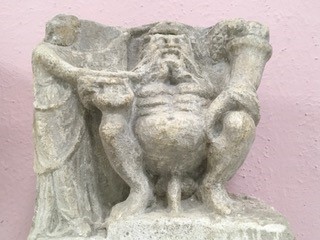
In addition to the Museums we also took in ancient walls, an old fashioned shoe shine, C18th Ottoman Bridge, Communist Era Buildings and discarded Bronze Lenin and Stalin statuary, modern street art, parks, modern sky scrapers and shopping malls and tantalising posters advertising Shakespeare, Racine and Sophocles!
Would we return? Most definitely! There is so much more to explore, the Hotels and food are excellent and the hospitality is superb.
Thank you so much to Carolyn and Jimmy.
Courier/Guide/Language problems?
i – Courier deffo; but not for language – just for ease……..and to point out archaeological topography! Pompey & Caesar’s Camps for example en route!
ii – We usually seek out the youngsters if we don’t speak the local language. Here? The elders speak Greek!
iii – Site Guides? For a School Trip, yes. Some Sites would benefit from a knowledgeable and experienced Guide to bring them to life – unless you are prepared to swot up and work hard yourself.
What on the Itinerary, would we alter?
i – Maybe only a half-day in Durres?
ii – Omit Amantia? We loved it, but largely because it was so unspoiled. We’d say just for enthusiasts…….ie those who appreciate manure piles shored up pottery sherds!
iii – Be proactive and acquire a photographic permit. We really only had a problem in Durres; but with 30 odd pupils? Who knows………..
iv – Add a stop at Sarande? Too Touristy for us, but we missed out on the archaeological centre because we were restricted by parking
v – Gjirokastra for one night only? It’s an important cultural town in its own right and necessary for Antigonia
vi – Berat main town for an Hotel. Guva Mangalem Hotel was amazing, but the access is not suitable for a School Group!
vii – Include if possible the archaeological sites of Oricum (inside a naval base thus permits necessary, which we did not have) and Finiq (another steep climb)
Further Reading
i – Tirana. The City Poised to Become Europe’s Next Affordable Creative Haven – The New York Times
ii – Albania Archaeological Parks
iii – The Land of the Illyrians
iv – Albanian History on Twitter
v – An ancient city brought to light at Babunjë, Albania
vi – Durres – ALBATRIP
vii – A Roman temple at Romanat, Durrës?
viii – Berat Castle: From Antiquity to the Present Day
ix – Hadrianopolis Excavations
x – The Durres (Epidamnus/Dyrrachium) Regional Archaeological Project
xi – Chronicle in Stone by Ismail Kadare

